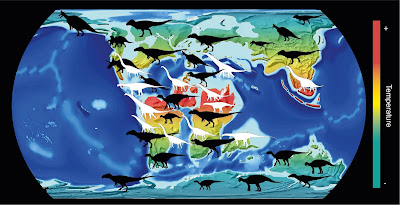Then birds are as warm blooded as they come and are direct descendents. I do think that the Northern Reptiles all had feathers or fur. unless they were also aquatic. That particularly include Pterosaurs.
We only have to look at the distribution of Alliators and crocodiles to understand the limitation of cold blooded animals. Without water, protection becomes necessary.
It is time we set this debate aside and understand that temporate zone reptiles fully used cover, just as mammals do today.
Sauropod Dinosaurs Were Restricted To Warmer Regions Of Earth
https://archaeologynewsnetwork.blogspot.com/2021/12/sauropod-dinosaurs-were-restricted-to.html
Giant, long-necked sauropods, thought to include the largest land animals ever to have existed, preferred to live in warmer, more tropical regions on Earth, suggesting they may have had a different physiology from other dinosaurs, according to a new study led by researchers at UCL and the University of Vigo.
Original artwork from scientific illustrator Emiliano Troco depicting a Brontosaurus (likely the most famous sauropod dinosaur) acting as an ecosystem engineer in a warm and vegetated landscape not dissimilar to modern-day savannah type biomes. The animal is basking in a semi-arid open landscape where temperature conditions might have favored their ecology: as hypothesized in our paper, sauropods might have been an exception in Dinosauria for being solely capable of inhabiting warmer, lower latitude environments, where might have been more efficient, maybe hinting to a more heterotherm-inclined thermophysiology than other dinosaur groups, i.e. theropods and ornithischians [Credit: Emiliano Troco]
The study, published in the journal Current Biology, investigated the enigma of why sauropod fossils are only found at lower latitudes, while fossils of other main dinosaur types seem ubiquitously present, with many located in the polar regions.
The researchers analyzed the fossil record across the Mesozoic era (the time of the dinosaurs), lasting from around 230 to 66 million years ago, looking at occurrences of fossils of the three main dinosaur types: sauropods, which include the Brontosaurus and the Diplodocus, theropods ("lizard-hipped"), which include velociraptors and Tyrannosaurus rex, and ornithischians ("bird-hipped") such as the Triceratops.
Combining this fossil data with data about climate throughout the period, along with information about how continents have moved across the globe, the researchers concluded that sauropods were restricted to warmer, drier habitats than other dinosaurs. These habitats were likely to be open, semi-arid landscapes, similar to today's savannahs.
Co-author Dr. Philip Mannion (UCL Earth Sciences) says that their "research shows that some parts of the planet always seemed to be too cold for sauropods. They seem to have avoided any temperatures approaching freezing. Other dinosaur types, in contrast, could thrive in Earth's polar regions, from innermost Antarctica to polar Alaska—which, due to the warmer climate, were ice-free, with lush vegetation."
"This suggests sauropods had different thermal requirements from other dinosaurs, relying more on their external environment to heat their bodies—slightly closer to being 'cold-blooded', like modern-day reptiles. Their grand size hints that this physiology may have been unique."
First author Dr. Alfio Alessandro Chiarenza, formerly of UCL who is now based at the University of Vigo, Spain, says that "it may be that sauropods were physiologically incapable of thriving in colder regions, or that they thrived less well in these areas than their dinosaurian cousins and were outcompeted."
"A mix of features may have helped sauropods shed heat more easily than mammals do today. Their long necks and tails would have given them a larger surface area, and they may have had a respiratory system more akin to birds, which is much more efficient."
Graphical abstract showing the latitudinally more restricted distribution of sauropod dinosaurs (white)
compared to other dinosaurs (in black) [Credit: Current Biology]
"Some species of theropods and ornithischians are known to have had feathers or downy fur helping them retain body warmth. This suggests they may have generated their own body heat. For sauropods, however, there is no evidence of this kind of insulation."
"Sauropods' strategies for keeping their eggs warm may also have differed from the other dinosaurs. Theropods probably warmed eggs by sitting on them, whereas ornithischians seem to have used heat generated by decaying plants. Sauropods, meanwhile, may have buried their eggs, relying on heat from the sun and the ground."
In their paper, the researchers noted that the fossil record showed zero occurrences of sauropods above a latitude of 50 degrees north—an area encompassing most of Canada, Russia, northern Europe and the UK—or below 65 degrees south, encompassing Antarctica. In contrast, there are rich records for theropods and ornithischians living above 50 degrees north in later periods (from 145 million years ago).
To test if this was a true reflection of where sauropods lived, researchers used a statistical technique to adjust for gaps in the fossil record, and also analyzed where the highest diversities of dinosaur types were in different periods throughout the Mesozoic era.
They combined fossil data with climate data, allowing an estimate of the temperature ranges of the dinosaur types' habitats, finding that sauropods' range across the latitudes was more restricted during colder periods. They then used habitat modeling to infer which regions of the globe would likely be suitable for sauropods and the other dinosaur types to live.
While in the past it was believed that dinosaurs were ectothermic ("cold-blooded"), like reptiles today, relying on the external environment to heat their bodies, it is now thought they were closer to "warm-blooded" mammals, generating some of their own body heat (endothermic).
The study authors said sauropods may have had a unique in-between physiology, closer to being cold-blooded than other dinosaur types.


No comments:
Post a Comment